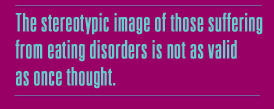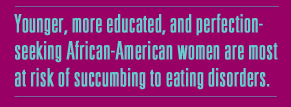 |
 |
Minority Women: The Untold Story
by Marian Fitzgibbon and Melinda Stolley
"I think about food constantly. I am always trying to control the calories and
fat I eat, but so often I end up overeating. Then I feel guilty and vomit or
take laxatives so I won't gain weight. Each time this happens I promise myself
that the next day I will eat normally and stop the vomiting and laxatives.
However, the next day the same thing happens. I know this is bad for my body,
but I am so afraid of gaining weight."
 This vignette describes the daily existence of one person seeking treatment for
an eating disorder in our clinic. A second person reported, "I don't eat all
day and then I come home from work and binge. I always tell myself I'm going to
eat a normal dinner, but it usually turns into a binge. I have to re-buy food
so no one notices all the food is gone."
This vignette describes the daily existence of one person seeking treatment for
an eating disorder in our clinic. A second person reported, "I don't eat all
day and then I come home from work and binge. I always tell myself I'm going to
eat a normal dinner, but it usually turns into a binge. I have to re-buy food
so no one notices all the food is gone."
Stop for a moment and try to envision these two individuals. For most people,
the image of a young, middle-class, white female comes to mind. In fact, the
first quote came from "Patricia," a 26-year-old African-American female, and
the second from "Gabriella," a 22-year-old Latina* woman.
Recently, it has become apparent that the stereotypic image of those suffering
from eating disorders may not be as valid as once thought. A primary reason why
eating disorders appeared to be restricted to white women seems to be that
white women were the only people with these problems who underwent study.
Specialists conducted most of the early research in this area on college
campuses or in hospital clinics. For reasons related to economics, access to
care, and cultural attitudes toward psychological treatment, middle-class white
females were the ones seeking treatment and thus the ones who became the
subjects of research.
Defining eating disorders
Experts have identified three major categories of eating disorder:
- Anorexia nervosa is characterized by the incessant pursuit of thinness, an
intense fear of gaining weight, a distorted body image, and a refusal to
maintain a normal body weight. Two types of anorexia nervosa exist. Those
suffering from the so-called restricting type severely restrict their caloric
intake by extreme dieting, fasting, and/or excessive exercise. Those of the
so-called binge-eating purging type exhibit the same restricting behavior but
also fall victim to bouts of gorging, which they follow with vomiting or
abusing laxatives or diuretics in an attempt to counteract the
overeating.
- Bulimia nervosa consists of episodes of binge eating and purging that
occur an average of twice a week for at least three months. Binge eaters devour
an excessive amount of food in a brief period of time, during which they feel a
general loss of control. A characteristic binge might include a pint of ice
cream, a bag of chips, cookies, and large quantities of water or soda, all
consumed in a short time. Again, purging behavior such as vomiting, abusing
laxatives or diuretics, and/or excessive exercise occurs after the binge in an
effort to get rid of the calories taken in.
- Binge-eating disorder (BED) is a more recently described disorder that
comprises bingeing similar to bulimia but without the purging behavior used to
avoid gaining weight. As among bulimics, those experiencing BED feel a lack of
control and undergo bingeing an average of twice a week.
 It may come as a surprise to some that both bulimia and BED are more common
than anorexia. Interestingly, prior to the 1970's, eating-disorder specialists
rarely encountered bulimia, yet today it is the most commonly treated eating
disorder. Many experts believe the rise in rates of bulimia has to do in part
with western society's obsession with thinness and the shifting role of women
in a culture that glorifies youth, physical appearance, and high achievement.
Eating-disorder therapists are also treating more individuals with BED.
Although doctors identified binge eating without purging as early as the
1950's, BED was not systematically studied until the 1980's. As such, the
apparent increase in BED incidence may merely reflect an increase in BED
identification. Among females, typical rates for bulimia are 1 to 3 percent and
for anorexia 0.5 percent. The prevalence of significant binge eating among
obese persons in community populations is higher, ranging from 5 to 8
percent.
It may come as a surprise to some that both bulimia and BED are more common
than anorexia. Interestingly, prior to the 1970's, eating-disorder specialists
rarely encountered bulimia, yet today it is the most commonly treated eating
disorder. Many experts believe the rise in rates of bulimia has to do in part
with western society's obsession with thinness and the shifting role of women
in a culture that glorifies youth, physical appearance, and high achievement.
Eating-disorder therapists are also treating more individuals with BED.
Although doctors identified binge eating without purging as early as the
1950's, BED was not systematically studied until the 1980's. As such, the
apparent increase in BED incidence may merely reflect an increase in BED
identification. Among females, typical rates for bulimia are 1 to 3 percent and
for anorexia 0.5 percent. The prevalence of significant binge eating among
obese persons in community populations is higher, ranging from 5 to 8
percent.
|  Next to white women,
African-American women have been studied the most when it comes to eating
disorders. Yet apparent contradictions exist in the data.
Next to white women,
African-American women have been studied the most when it comes to eating
disorders. Yet apparent contradictions exist in the data.
|
As the field of eating disorders has evolved, researchers and therapists have
begun seeing a number of changes. These include an increase in eating disorders
among men (see One Man's Battle). While the vast majority of anorexics
and bulimics are female, for example, a higher percentage of men are now
struggling with BED. And despite the common wisdom that minority women have a
kind of cultural immunity to developing eating disorders, studies indicate that
minority females may be just as likely as white females to develop such
debilitating problems.
"Patricia" and other African-Americans
Of all minority groups in the U.S., African-Americans have undergone the most
study, yet results bear apparent contradictions.
On the one hand, much of the research suggests that even though
African-American women are heavier than white women—49 percent of black
females are overweight as opposed to 33 percent of white females—they are
less likely to have disordered eating than white women are. In addition,
African-American women are generally more satisfied with their bodies, basing
their definition of attractiveness on more than simply body size. Instead, they
tend to include other factors such as how a woman dresses, carries, and grooms
herself. Some have considered this broader definition of beauty and greater
body satisfaction at heavier weights a potential protection against eating
disorders. In fact, some studies conducted in the early 1990's indicate that
African-American women exhibit less restrictive eating patterns, and that, at
least among those who are college students, are less likely than white women to
engage in bulimic behaviors.
 The overall picture is not so clear, however. Take, for example, Patricia's
story. Patricia's struggle with daily bingeing followed by vomiting and
laxative abuse is not unique. Nearly 8 percent of the women we see in our
clinic are African-American, and our clinical observations parallel research
studies reporting that African-American women are just as likely to abuse
laxatives as white women are. Data from a recent large, community-based study
give more reason for concern. The results indicate that more African-American
women than white women report using laxatives, diuretics, and fasting to avoid
weight gain.
The overall picture is not so clear, however. Take, for example, Patricia's
story. Patricia's struggle with daily bingeing followed by vomiting and
laxative abuse is not unique. Nearly 8 percent of the women we see in our
clinic are African-American, and our clinical observations parallel research
studies reporting that African-American women are just as likely to abuse
laxatives as white women are. Data from a recent large, community-based study
give more reason for concern. The results indicate that more African-American
women than white women report using laxatives, diuretics, and fasting to avoid
weight gain.
Much research is now focused on identifying factors that affect the onset of
eating disorders among African-American women. It seems that eating disorders
may relate to the degree to which African-American women have assimilated into
the dominant American social milieu—that is, how much they have adopted the
values and behaviors of the prevailing culture. Not surprisingly,
African-American women who are the most assimilated equate thinness with beauty
and place great importance on physical attractiveness. It is these typically
younger, more educated, and perfection-seeking women who are most at risk of
succumbing to eating disorders.
Patricia fits this profile. Recently graduated from law school, she moved to
Chicago to take a position with a large law firm. Each day she strives to do
her job perfectly, eat three low-calorie, low-fat meals, avoid all sweets,
exercise for at least an hour, and lose weight. Some days she is successful,
but many days she cannot maintain the rigid standards she has set for herself
and ends up bingeing and then purging. She feels quite alone with her eating
disorder, believing that her eating troubles are not the kind of problems that
her friends or family could possibly understand.
|  Like African-American women, Latina women were thought to possess a kind
of cultural immunity to eating disorders, but current trends disprove that.
Like African-American women, Latina women were thought to possess a kind
of cultural immunity to eating disorders, but current trends disprove that.
|
"Gabriella" and other Latinas
As the fastest-growing minority population in the U.S., Latinas have been
increasingly included in studies of disordered eating. Like African-American
women, Latina women were thought to bear cultural immunities to eating
disorders because they have a preference for a larger body size, place less
emphasis on physical appearance, and generally pride themselves on a stable
family structure.
Studies are now challenging this belief. Research suggests that white and
Latina women have similar attitudes about dieting and weight control.
Further, prevalence studies of eating disorders indicate similar rates for
white and Latina girls and women, particularly when considering bulimia and
BED. As with African-Americans, it appears that eating disorders among
Latinas may be related to acculturation. Thus, as Latina women attempt to
conform to the majority culture, their values change to incorporate an emphasis
on thinness, which places them at higher risk for bingeing, purging, and overly
restrictive dieting.
Consider Gabriella. She is a young Mexican woman whose parents moved to the
U.S. when she was just a child. While her mother and father continue to speak
Spanish at home and place a high value on maintaining their Mexican traditions,
Gabriella wants nothing more than to fit in with her friends at school. She
chooses to speak only English, looks to mainstream fashion magazines to guide
her clothing and make-up choices, and wants desperately to have a fashion-model
figure. In an attempt to lose weight, Gabriella has made a vow to herself to
eat only one meal a day—dinner—but on her return home from school, she is
rarely able to endure her hunger until dinnertime. She often loses control and
ends up "eating whatever I can get my hands on." Frantic to keep her problem
hidden from her family, she races to the store to replace all the food she has
eaten.
Gabriella says that although she has heard her "Anglo" friends talk about
eating problems, she has never heard of anything like this in the Latina
community. Like Patricia, she feels isolated. "Yeah, sure, I want to fit in
with mainstream America," she says, "but I hate what this bingeing is doing to
my life."
Despite an apparent rise in such problems among Latina women, it is
difficult to assess the status of eating disorders among them for three
reasons. First, little research has been conducted on this group. Second, the
few studies that have been done are somewhat flawed. Many studies, for example,
have based their conclusions on very small groups of women or on groups
comprised only of clinic patients. Finally, most studies have neglected to
consider the role that factors like acculturation or country of origin (e.g.,
Mexico, Puerto Rico, Cuba) might have on the prevalence, type, or severity of
eating disorders.
 Information on Asian-Americans,
Native Americans, and other minorities with eating disorders remains scant, and
more research is urgently needed.
Information on Asian-Americans,
Native Americans, and other minorities with eating disorders remains scant, and
more research is urgently needed.
|
|
Other minorities
As with all minority groups, not enough is known about eating disorders among
Asian-American women. Available research, which has focused on adolescents or
college students, appears to indicate that eating disorders are less prevalent
in Asian-American females than in white females. Asian-American women report
less binge eating, weight concerns, dieting, and body dissatisfaction. But to
come to any firm conclusions about eating disorders within this ethnic group,
researchers need to gather more information across different ages, levels of
acculturation, and Asian subgroups (e.g., Japanese, Chinese, Indian).
Among Native American populations, the scant available information suggests
that aberrant eating patterns more often strike heavier individuals and that
purging behaviors such as vomiting and laxative abuse are used to control
weight. Research has also noted that younger women with higher levels of
education, as well as those who have moved off reservations and are
assimilating into western culture, are at increased risk.
Stemming the trend
The study of eating disorders in minority populations in the U.S. remains in its
infancy. Yet as the stories of Patricia and Gabriella reveal, minority women
with eating disorders experience the same feelings of shame, isolation, pain,
and struggle as their white counterparts. Sadly, clinical anecdotes suggest
that disordered eating behavior among minority women often goes unnoticed until
it reaches dangerous levels. Only stepped-up research and efforts to increase
awareness of the dangers can begin to stem this disturbing trend.
* Editor's note: While both "Hispana" and "Latina" are commonly used today, we use the term "Latina" in this article.
 |
|
Drs. Marian L. Fitzgibbon (right in photo) and Melinda R. Stolley are part of the Eating
Disorders Program in the Department of Psychiatry and Behavioral Sciences at
Northwestern University Medical School. |
Photos: (1-3) Corbis Images
Ask the Experts |
Watch the Program |
Share Your Story
Help/Resources |
Minority Women: The Untold Story |
One Man's Battle
Body Needs |
Transcript |
Site Map |
Dying to be Thin Home
Editor's Picks |
Previous Sites |
Join Us/E-mail |
TV/Web Schedule
About NOVA |
Teachers |
Site Map |
Shop |
Jobs |
Search |
To print
PBS Online |
NOVA Online |
WGBH
© | Updated December 2000
|
|
|